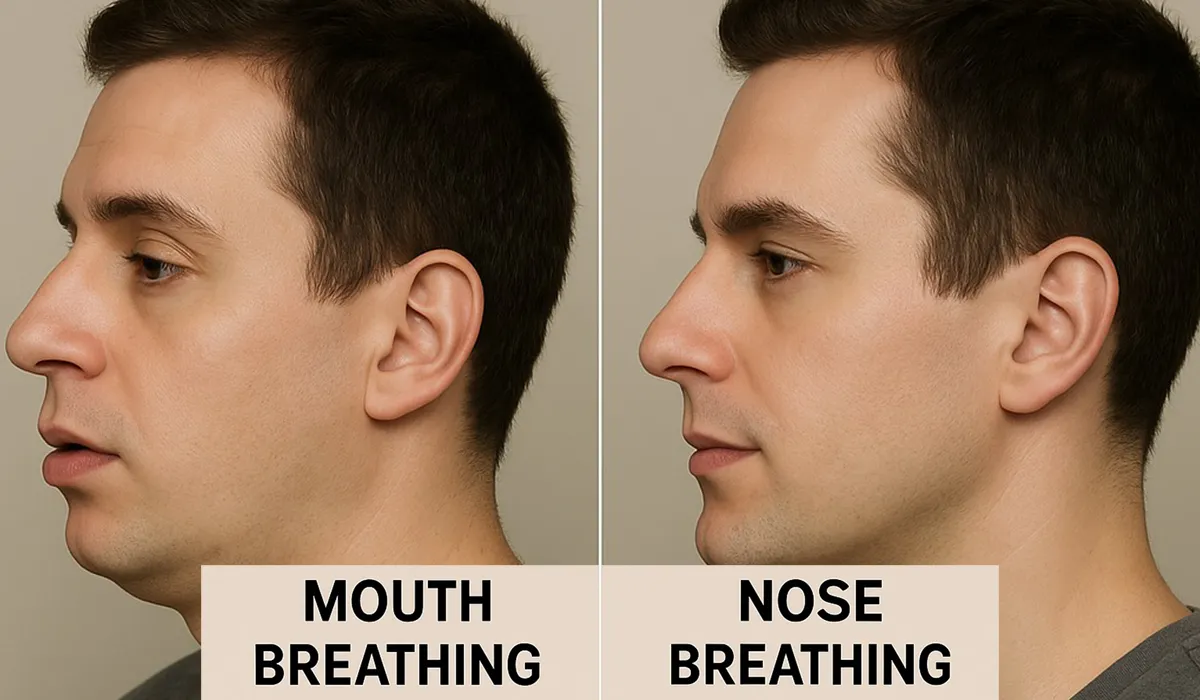What do we have noses for? Not just for smelling or holding up our glasses! More than just a facial feature or a tool for smelling, the nose is a sophisticated filtration system that warms, humidifies, and purifies each breath before it reaches your lungs. Most of us instinctively know our noses are meant for breathing, yet many unknowingly fall into the habit of using our mouths instead.
When nasal passages become blocked due to congestion, allergies, or structural issues, the body adapts by breathing through the mouth—triggering a chain reaction of oral health issues. Saliva flow diminishes, creating a breeding ground for cavity-causing bacteria, while dry gum tissues become inflamed. Over time, mouth breathing can even alter facial development, especially in children, affecting jaw structure and tooth alignment.
Beyond dental concerns, chronic mouth breathing can lead to persistent bad breath, disrupted sleep, and an increased risk of conditions like temporomandibular joint (TMJ) disorders and sleep apnoea. What starts as a simple adaptation to nasal blockages can silently reshape your oral health, appearance, and overall wellbeing. If you suspect mouth breathing is affecting you or your child, addressing it early can prevent long-term complications.
What mouth breathing means for oral health

Dry mouth and pH imbalances
Saliva isn’t just spit — it’s your mouth’s frontline defence. Mouth breathing dries it up, stripping away your natural shield. Without it, acids rise, bacteria thrive, and your enamel starts to dissolve. The result? A more acidic mouth that fast-tracks tooth decay and gum disease.
Increased risk of cavities
Saliva acts as a natural defence against tooth decay by remineralising enamel and neutralising acids produced by bacteria. When the mouth remains dry due to persistent mouth breathing, these protective mechanisms become compromised. As a result, harmful bacteria multiply rapidly, leading to plaque buildup and an increased risk of cavities. Over time, untreated cavities can cause severe tooth damage, pain, and potential tooth loss.
Gum disease and inflammation
Mouth breathing dries out your mouth and disrupts the natural balance of oral bacteria. Without enough saliva to rinse away debris and neutralise acids, harmful microbes take over. Inflammation follows — bringing redness, swelling, and bleeding gums. Left untreated, this can escalate to gum recession, bone loss, and loose teeth. What starts as a little dryness can end with serious damage to your smile.
Orthodontic issues and facial development
Chronic mouth breathing in children can significantly affect facial and jaw development, often resulting in a long, narrow face, a high-arched palate, and misaligned teeth. Poor tongue posture—common in mouth breathers—prevents proper upper jaw expansion, increasing the risk of dental crowding, overbites, and other orthodontic concerns. Even in adults, persistent mouth breathing can gradually worsen dental misalignment, potentially leading to bite issues that require orthodontic treatment.
Temporomandibular joint (TMJ) disorders
Your jaw isn’t built to hang open all day. Mouth breathing can alter the natural resting position of the jaw, often shifting it forward and placing ongoing strain on the temporomandibular joint (TMJ). Over time, this added pressure can lead to joint dysfunction, resulting in symptoms such as jaw pain, frequent headaches, clicking or popping sounds, and difficulty chewing. Left unaddressed, TMJ disorders can worsen, affecting overall jaw function and leading to chronic discomfort that impacts daily life.
Sleep disorders and snoring
Mouth breathing is closely linked to sleep disorders such as snoring and obstructive sleep apnoea (OSA). Breathing through the mouth during sleep can cause the airway to collapse, leading to disrupted breathing patterns and reduced oxygen intake. This not only dries out the mouth, increasing the risk of oral health issues, but also contributes to poor sleep quality, daytime fatigue, and a higher risk of serious health conditions like high blood pressure, heart disease, and diabetes.
Why we mouth breathe
Chronic mouth breathing can result from a range of contributing factors, including:

- Nasal congestion due to allergies, colds, or sinus infections, making nasal breathing difficult.
- Deviated septum or structural nasal obstructions that restrict airflow through the nose.
- Enlarged tonsils or adenoids, particularly in children, which can block nasal passages and force mouth breathing.
- Chronic stress or anxiety, which may lead to habitual open-mouth posture and shallow breathing.
- Poor oral habits, such as prolonged pacifier use or thumb-sucking in early childhood, which can contribute to improper tongue posture and airway obstruction.
- Asthma or respiratory conditions that make nasal breathing difficult, leading to compensatory mouth breathing.
- Nasal polyps or chronic sinusitis, which can cause persistent nasal blockage.
- Mouth or jaw structure issues, such as a recessed chin or narrow airway, which can make nasal breathing more challenging.
How to prevent and treat mouth breathing
Improving nasal breathing is vital for long-term wellness. The following strategies can help prevent and manage mouth breathing:

Nasal breathing exercises: Training yourself to breathe through the nose with conscious effort can help break the habit and strengthen nasal passages.
Orthodontic treatment: Addressing bite misalignment, jaw positioning, and other structural issues can reduce the tendency for mouth breathing and promote better oral posture.
Treating underlying conditions: Managing allergies, sinus infections, or nasal obstructions through medical intervention can improve nasal breathing.
Proper hydration: Drinking enough water supports saliva production, helping maintain a healthy oral environment.
Using a humidifier: Adding moisture to the air, especially at night, can prevent excessive mouth dryness and support oral health.
Myofunctional therapy: Performing exercises that strengthen facial and tongue muscles can encourage proper nasal breathing and oral posture, reducing reliance on mouth breathing.
Breathe better for a healthier smile
Mouth breathing is more than just a harmless habit—it disrupts oral health, alters facial development, and affects overall wellbeing. From dry mouth and cavities to gum disease, jaw misalignment, and sleep disturbances, its effects can be immediate and long-term.
Early diagnosis is key. If you or your child frequently breathe through the mouth, consulting a dentist, orthodontist, or ENT specialist can help identify the cause and prevent lasting damage. Restoring nasal breathing does more than protect your smile—it enhances oxygen intake, supports cognitive function, promotes proper facial development, and improves sleep quality. By addressing this often-overlooked aspect of health, you’re not just safeguarding your oral health—you’re optimising your body’s natural function in so many ways.
Make the switch to nasal breathing today — because a healthier smile starts with every breath.






